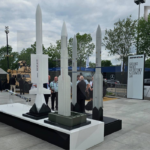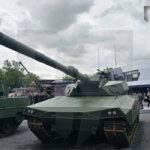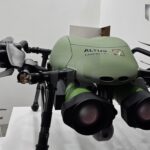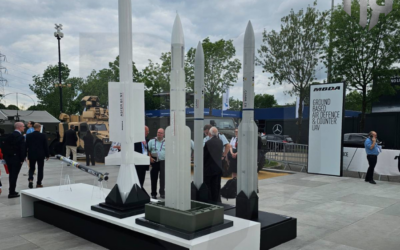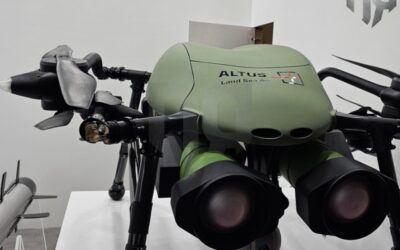With such a large number of interested attendees at MBDA’s pavilion at the Eurosatory 2024 Defence exhibition, the stand reminded of an…
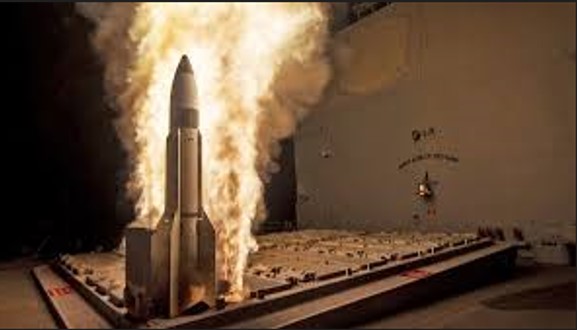
In a historic first, US Navy Arleigh Burke-class destroyers deployed Standard Missile-3 (SM-3) anti-missile interceptors in combat, successfully intercepting Iranian ballistic missiles aimed at Israeli targets.
Over the weekend, the Israel Defence Forces (IDF) reported that a staggering 350 Iranian missiles and drones were launched at Israel, carrying a combined payload of 60 tons of explosives. Among them were approximately 120 ballistic missiles, 30 cruise missiles and 170 drones.
The IDF declared that 99 per cent of the threats were intercepted, with the US Navy accounting for a substantial part of this effort. According to reports, the USS Carney and USS Arleigh Burke collectively shot down at least four ballistic missiles: the USS Carney specifically intercepted three missiles, while the USS Arleigh Burke intercepted one.
These destroyers, equipped with the SPY-1D radar and SM-3 interceptors, demonstrated their capability to detect and eliminate ballistic threats before they could reach their intended targets.
The deployment of SM-3 interceptors indicates that Iran most likely employed medium-range ballistic missiles with a range of up to 1,800 miles. Despite the fact that SM-3 interceptors have been a crucial component of the US ballistic missile defence network since 2004, this marked their inaugural use in an actual combat scenario.
SM-3 interceptors have undergone extensive testing over the past two decades, yet their deployment in combat signifies a critical milestone in missile defence technology.
Also read: BAE Systems | Delivery of next-generation digital IFF systems for the US Navy
RIM-161 Standard Missile 3 technical characteristics:
- Mass: 1.5 t
- Length: 6.55 m
- Diameter: 34.3 cm for Block I missiles / 53.3 cm for Block II
- Wingspan: 1.57 m
- Warhead: Lightweight Exo-Atmospheric Projectile (LEAP)
- Operational range: Block IA/B: 900 – 1200 km / Block IIA: 1,200 km
- Maximum speed: 3 km/s (Mach 8.8) Block IA/B / 4.5 km/s (Mach 13.2) Block ΙΙ
Operation and performance
The ship’s AN/SPY-1 radar locates the ballistic missile target and the Aegis weapon system calculates a solution based on ballistic data against the target. The Aerojet MK 72 solid-fuel rocket booster launches the SM-3 out of the ship’s Mark 41 Vertical Launching System (VLS).
The missile then establishes communication with the launching ship. Once the booster burns out, it detaches, and the Aerojet MK 104 solid-fuel dual thrust rocket motor (DTRM) takes over propulsion through the atmosphere. The missile continues to receive mid-course guidance information from the launching ship and is aided by GPS data.
The ATK MK 136 solid-fueled third-stage rocket motor (TSRM) fires after the second stage burns out and it takes the missile above the atmosphere (if needed). The TSRM is pulse fired and provides propulsion for the SM-3 until 30 seconds to intercept.
At that point the third stage separates and the Lightweight Exo-Atmospheric Projectile (LEAP) kinetic warhead begins to search for the target using pointing data from the launching ship.
The Aerojet throttleable divert and attitude control system (TDACS) allows the warhead to manoeuvre in the final phase of engagement. The kinetic warhead’s sensors identify the target, attempt to identify its most lethal part and steer to that point. If the kinetic warhead intercepts the target, it provides 130 megajoules of kinetic energy at the point of impact.
Also read: US Navy | To test microwave Anti-Drone weapon system at sea in 2026
With information from: USNI news
READ MORE
KNDS | Showcases full range of LEOPARD battle tanks at EUROSATORY
KNDS continues to expand its technological advantage in the field of main battle tank development, as we have witnessed at the Defence and…
THEON SENSORS | Distinguishing appearance at EUROSATORY 2024 with new range of products
THEON SENSORS attended the International Defence and Security Exhibition EUROSATORY 2024 as an ambassador of Greek innovation…
EUROSATORY 2024 | Missile Artillery Solutions from MBDA
With such a large number of interested attendees at MBDA’s pavilion at the Eurosatory 2024 Defence exhibition, the stand reminded of an…
KNDS | Showcases full range of LEOPARD battle tanks at EUROSATORY
KNDS continues to expand its technological advantage in the field of main battle tank development, as we have witnessed at the Defence and…
THEON SENSORS | Distinguishing appearance at EUROSATORY 2024 with new range of products
THEON SENSORS attended the International Defence and Security Exhibition EUROSATORY 2024 as an ambassador of Greek innovation…
Ministry of Defence | Organization of Hellenic EDF Info Day
A Conference entitled “EDF Info Day” is organized in the Amphitheater of the National Gallery on Tuesday, July 9 from 09:00 to 17:00.
ALTUS LSA | Participates in EUROSATORY 2024 with KERVEROS in the foreground
The participation of ALTUS LSA in EUROSATORY 2024 is among the Greek participations of operational significance.
Freddy Beleris | Ιn jail until October
The elected mayor of Heimarra and Member of the European Parliament of New Democracy will remain in prison until October…







